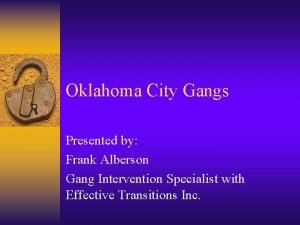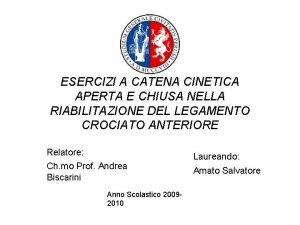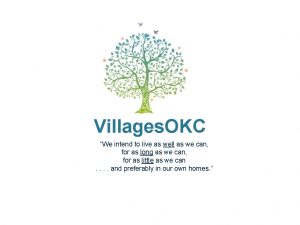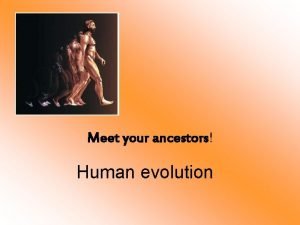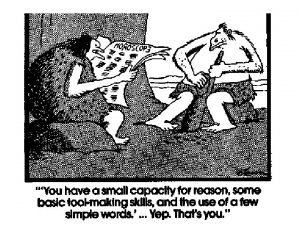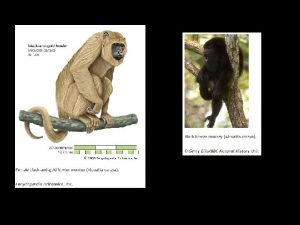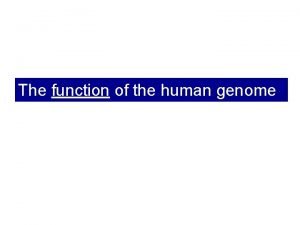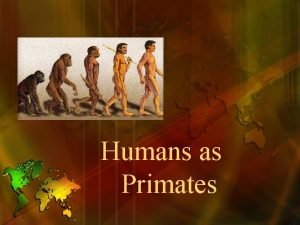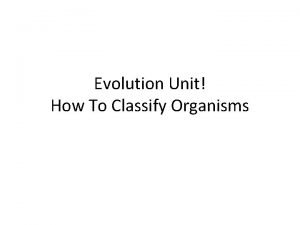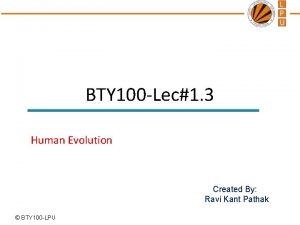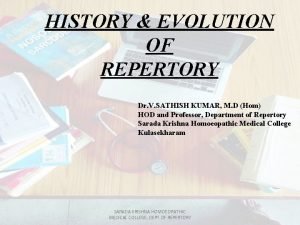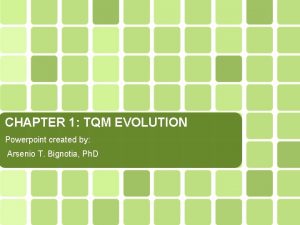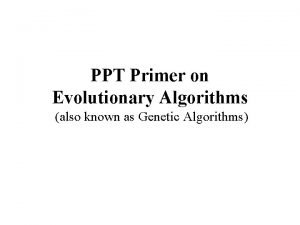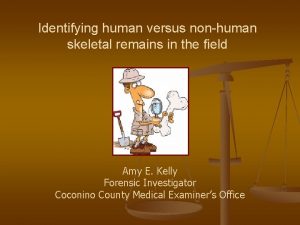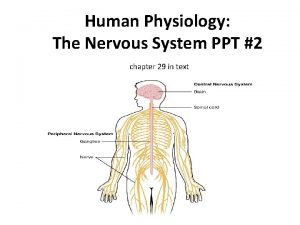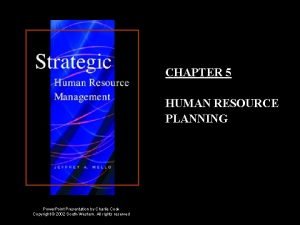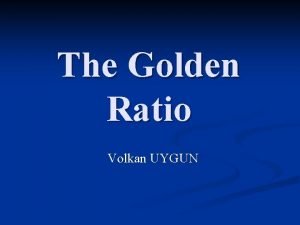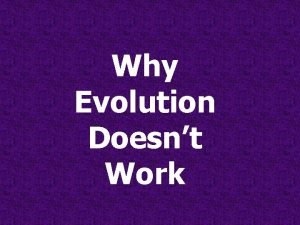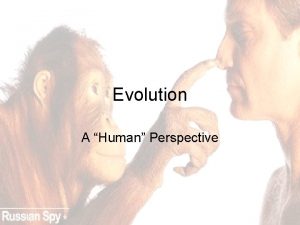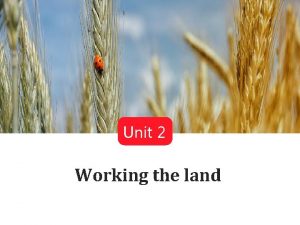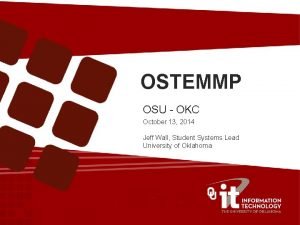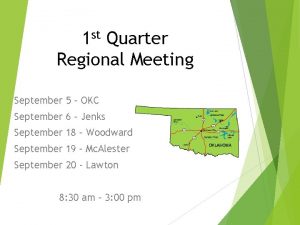Human Evolution www okc cc ok usdeandersonindexhumanevolution ppt



































- Slides: 35

Human Evolution www. okc. cc. ok. us/deanderson/index/human_evolution. ppt

The Evolution of Humans 2

Theory of Evolution • Science has overwhelming evidence that all life is constantly evolving 3

Natural Selection • One mechanism of evolution • Main concepts of natural selection – Overproduction of offspring – Inherited variation in offspring – Competition – Best adapted in a given environment survive and reproduce to increase their kind • They are naturally selected 4

Overproduction of Offspring • Elephants (very slow reproductive rate) – If all the offspring of one elephant pair survive and all their offspring survive then: • 750 years = 19, 000 elephants • 1200 years = Enough elephants to cover the earth! • Beetles – A handful that weighs 10 mg each – 82 weeks • 61, 000, 000, 000 ton – The weight of the earth! 5

The Evolution of Humans 6

Variation of Offspring • Offspring of the same parents are different from each other 7

Competition • Since more individuals are born than can survive for an extended period of time, they compete for resources – Food – Living space – Mates 8

Best adapted to a given environment are selected to survive • Brown bears – Adapted to survive in Oklahoma • Polar bears – Adapted to survive in Alaska 9

The Evolution of Humans The Ecological Theatre · The Stage: East Africa · The Setting: A time of unrest. . . · Geologically… · The rift zone - uplifts, rifting, volcanoes · Climatically… · A series of glaciations · Global climate change · Changes in sea level 10

Sequence of Human Evolution • Hundreds of fossils have been found • Some of the major fossils will be discussed in this presentation 11

Australopithicus afarensis • • • 3. 5 million years ago Nicknamed Lucy Walked upright Small brain Skeleton human like – Feet – Pelvis – Upright stance 12

Comparative Anatomy Lucy Gorilla Human • Gorilla pelvis adapted for knuckle walking • Human pelvis adapted for upright walking • Lucy’s pelvis very similar to human pelvis 13

Knuckle Walking • Requires an elongated pelvis and long arms 14

Lucy’s pelvis allowed her to walk like a human instead of an ape. 15

Fossilized Footprints • Footprints left when a a pair of Australopithecines walked in the ash of a recently erupted volcano 16

Skull Anatomy Lucy Chimp • Thick brow ridges like a chimpanzee • Cranial capacity 400 cc. Chimp 350 cc. • Teeth similar to human teeth 17

Lucy: A Transitional Fossil • Transitional fossil shows characteristics of two kinds of animals – Represent the transition from one organism to another • Ape characteristics – Skull – Cranial capacity • Human characteristics – Walked upright – Feet – Pelvis 18

Australophithicus africanus • 2. 8 million years ago • Cranial capacity 460 cc 19

Homo habilis • Cranial capacity 630 cc • Flatter face than Australopithecines • Used tools – Nicknamed handy man 20

Homo erectus • 1. 8 million to 35, 000 years ago • 1, 000 cc cranial capacity • Large brow ridges • Sloping forehead • More advanced tools than H. habilis 21

Homo erectus • Skeleton very similar to modern man • Used fire • Traveled – Fossils found in Africa, Europe, China, Indonesia 22

Homo neanderthalensis • 135, 000 to 25, 000 years ago • Cranial capacity up to 1750 cc – Larger than modern man • No chin • Sloping forehead • Buried dead with tools and flowers 23

The Evolution of Humans The Cro-Magnons and the Neanderthals 24

Homo sapiens • 200, 000 years ago to present – Photo is a skull 100, 000 years old • 1400 cc cranial capacity • Vertical forehead • Pronounced chin 25

The Evolution of Humans • What about the Neanderthals? 26

The Evolution of Humans • What about the Cro Magnons? 27

Modern Homo sapiens • Small front teeth • Small brow ridges • Rounded cranium 28

Sequence of Human Evolution One of several possibilities Homo neanderthalensis Australopithicus afarensis Common ancestor Australopithicus africanus Homo habilis Homo erectus Homo sapiens Modern apes 29

Evolution of Skull • • • Cranial capacity increases for a larger brain Face become flatter Brow ridges become smaller Forehead becomes higher Chin develops 30

Tools used to learn about our evolutionary past • • Study of fossils Comparing DNA Comparing chromosomes Comparing protein sequences 31

Paleontology • Study of fossils – Allows us to see anatomical similarities between us and organisms that lived in the past – Allows us to see how our ancestors have changed over time 32

Comparing DNA • Human DNA compared to: – – Chimpanzee 99% same Gorilla 97. 7% same Orangutan 96. 3% same Another human 99. 9% same 33

The Evolution of Humans The Great Leap Forward • Due to evolution of a mechanism that allows speech and language? · Characterized by the appearance of. . . • Use of symbols. . . · Complex tools. . . · Innovations in hunting techniques and strategies. . . · Increased population size, development of social systems. . . · Houses, boats, long distance trade, ornaments · Art, music, rituals. . . 34

The Evolution of Humans 35
 Homo erectus ppt
Homo erectus ppt Redlands okc volleyball
Redlands okc volleyball Charge south volleyball
Charge south volleyball Pain management okc soonercare
Pain management okc soonercare Closed chain kinematics
Closed chain kinematics What gangs are in oklahoma
What gangs are in oklahoma Redlands okc volleyball
Redlands okc volleyball Catena cinetica anteriore esercizi
Catena cinetica anteriore esercizi Eric wenger okc
Eric wenger okc Public strategies okc
Public strategies okc Villagesokc
Villagesokc Oklahoma poison control center
Oklahoma poison control center Department of transportation
Department of transportation Rbc bearings hartsville sc
Rbc bearings hartsville sc Dryopithecus human evolution
Dryopithecus human evolution Human evolution
Human evolution Human evolution
Human evolution Human evolution
Human evolution Primates characteristics
Primates characteristics Human evolution
Human evolution Human evolution
Human evolution History and evolution of repertory
History and evolution of repertory Sharma card repertory pdf
Sharma card repertory pdf Evolution of tqm ppt
Evolution of tqm ppt Evolution of logistics ppt
Evolution of logistics ppt Human vs non human bones
Human vs non human bones Human needs and human development chapter 8
Human needs and human development chapter 8 Chapter 8 human needs and human development
Chapter 8 human needs and human development Gni definition ap human geography
Gni definition ap human geography Non human nouns
Non human nouns Resource management pmp
Resource management pmp Hrms.shanker group
Hrms.shanker group Human nervous system ppt
Human nervous system ppt Human resource planning model ppt
Human resource planning model ppt Golden ratio snowflake
Golden ratio snowflake Evidence of evolution
Evidence of evolution





